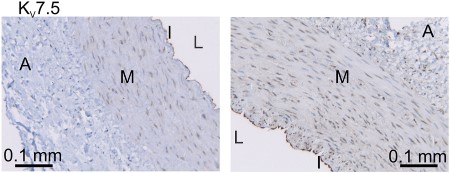Overview
Cat #:
APC-155
Alternative Name KV7.5, Potassium voltage-gated channel subfamily KQT member 5, KQT-like 5, KvLQT5
Lyophilized Powder yes
Type: Polyclonal
Host: Rabbit
Reactivity: H, M, R
Immunogen
- Peptide (C)RGSQDFYPKWRESK, corresponding to amino acid residues 856-869 of mouse KCNQ5 (Accession Q9JK45). Intracellular, C-terminus.
Accession (Uniprot) Number Q9JK45
Gene ID 226922
Peptide confirmation Confirmed by amino acid analysis and mass spectrometry.
Homology Human, rat - identical.
RRID AB_2341038.
Purity Affinity purified on immobilized antigen.
Form Lyophilized powder. Reconstituted antibody contains phosphate buffered saline (PBS), pH 7.4, 1% BSA, 0.05% NaN3.
Form Lyophilized powder. Reconstituted antibody contains phosphate buffered saline (PBS), pH 7.4.
Isotype Rabbit IgG.
Storage before reconstitution The antibody ships as a lyophilized powder at room temperature. Upon arrival, it should be stored at -20°C.
Reconstitution 25 µl, 50 µl or 0.2 ml double distilled water (DDW), depending on the sample size.
Reconstitution 0.2 ml double distilled water (DDW).
Antibody concentration after reconstitution 0.8 mg/ml.
Storage after reconstitution The reconstituted solution can be stored at 4°C for up to 1 week. For longer periods, small aliquots should be stored at -20°C. Avoid multiple freezing and thawing. Centrifuge all antibody preparations before use (10000 x g 5 min).
Standard quality control of each lot Western blot analysis.
Applications: ICC, IF, IHC, WB
Cited Applications: ICC*, IHC*
Western blot
- Rat hippocampus, mouse and rat brain lysates (1:200-1:1000).
 Western blot analysis of rat hippocampus (lanes 1 and 4), mouse brain (lanes 2 and 5) and rat brain (lanes 3 and 6) lysates:1-3. Anti-KCNQ5 Antibody (#APC-155), (1:200).
Western blot analysis of rat hippocampus (lanes 1 and 4), mouse brain (lanes 2 and 5) and rat brain (lanes 3 and 6) lysates:1-3. Anti-KCNQ5 Antibody (#APC-155), (1:200).
4-5. Anti-KCNQ5 Antibody, preincubated with KCNQ5 Blocking Peptide (#BLP-PC155).
Immunohistochemistry
- Rat hippocampus (free floating frozen sections) (1:100).
Immunocytochemistry
- Rat smooth muscle cells (1:100) (Morales-Cano, D. et al. (2015) Cardiovasc. Res. 106, 98.).
Scientific background
KCNQ genes encode members of the KV7 K+ channels. Structurally, the KCNQ family belongs to the six transmembrane domain category of K+ channels. Five members belong to this family (KCNQ1-KCNQ5) of which KCNQ2 to KCNQ5 are expressed in the nervous system1-3. KCNQ5 is also expressed in visceral smooth muscle4 and skeletal muscle5.
These channels form subunits of the low threshold voltage gated K+ channel. KCNQ2 and KCNQ3 mostly form heteromers to form the M current. KCNQ5 is known to contribute to this current1.
Application key:
CBE- Cell-based ELISA, FC- Flow cytometry, ICC- Immunocytochemistry, IE- Indirect ELISA, IF- Immunofluorescence, IFC- Indirect flow cytometry, IHC- Immunohistochemistry, IP- Immunoprecipitation, LCI- Live cell imaging, N- Neutralization, WB- Western blot
Species reactivity key:
H- Human, M- Mouse, R- Rat
Lyophilized Powder
Image & Title: 
Expression of KV7.5 (KCNQ5) in swine coronary artery.Immunohistochemical staining of swine coronary artery sections using Anti-KCNQ5 Antibody (#APC-155). KV7.5 staining (brown) is mostly detected in the intimal layer (I). Much lower staining is observed in medial layer (M).Adapted from Chen, X. et al. (2016) PLoS ONE 11, e0148569. with permission of PLoS.

Expression of KV7.5 (KCNQ5) in swine coronary artery.Immunohistochemical staining of swine coronary artery sections using Anti-KCNQ5 Antibody (#APC-155). KV7.5 staining (brown) is mostly detected in the intimal layer (I). Much lower staining is observed in medial layer (M).Adapted from Chen, X. et al. (2016) PLoS ONE 11, e0148569. with permission of PLoS.
For research purposes only, not for human use
Last Update: 25/03/2025
Specifications
Citations
Citations
